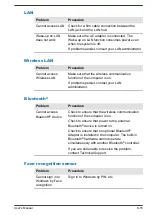
priorité) pour les bandes 5.25-5.35 GHz et 5.65-5.85 GHz et que ces
radars pourraient causer du brouillage et/ou des dommages aux dispositifs
LAN-EL.
The term “IC” before the equipment certification number only signifies that
the Industry Canada technical specifications were met.
USA - Federal Communications Commission (FCC)
This equipment has been tested and found to comply with the limits for a
Class B digital device, pursuant to Part 15 of FCC Rules. These limits are
designed to provide reasonable protection against harmful interference in a
residential installation.
Refer to the FCC information section for the detailed information.
Caution: Exposure to Radio Frequency Radiation
The radiated output power of the Wireless device is far below the FCC
radio frequency exposure limits. Nevertheless, the Wireless device shall be
used in such a manner that the potential for human contact during normal
operation is minimized.
In the usual operating configuration, the distance between the antenna and
the user should not be less than 20 cm. Please refer to the computer user’s
manual for the details regarding antenna location.
The installer of this radio equipment must ensure that the antenna is
located or pointed such that it does not emit RF field in excess of Health
Canada limits for the general population; consult Safety Code 6, obtainable
from Health Canada’s website
www.hc-sc.gc.ca
Caution: Radio Frequency Interference Requirements
This device is restricted to indoor use due to its operation in the 5.15 to
5.25 GHz frequency range.
High-power radars are allocated as primary users (i.e. priority users) of the
bands 5.25 to 5.35 GHz and 5.65 to 5.85 GHz and these radars could
cause interference and/or damage to LE-LAN devices.
Australia and New Zealand regulatory compliance
This equipment incorporates a radio transmitting device, in normal use a
separation distance of 20 cm will ensure radio frequency exposure level
complies with the Australian and New Zealand Standards.
Using this equipment in Japan
In Japan, the frequency bandwidth of 2,400 MHz to 2,483.5 MHz for
second generation low-power data communication systems such as this
equipment overlaps that of mobile object identification systems (premises
radio station and specified low-power radio station).
User's Manual
7-13














































